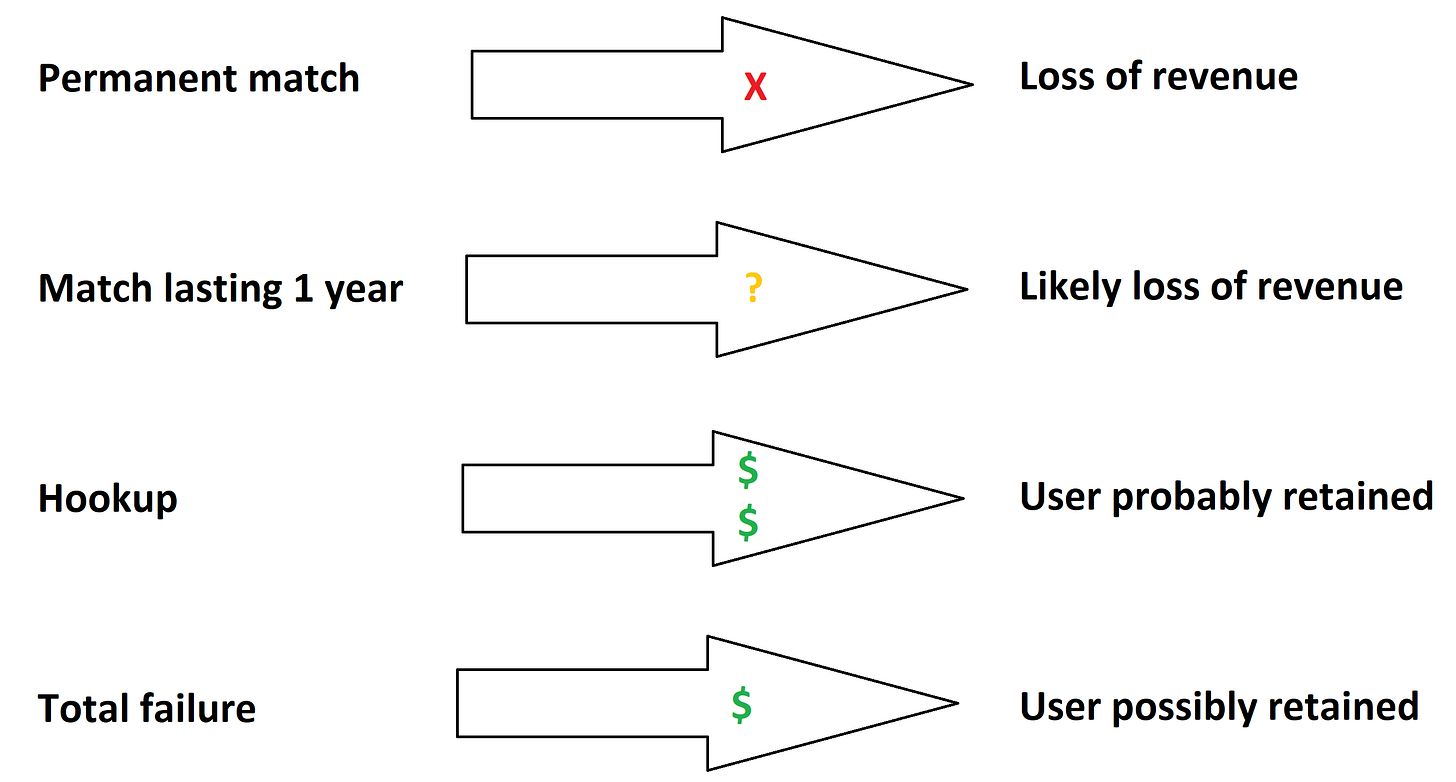I first drafted this back when I was actively using dating apps. I decided that I wouldn’t post it until after I had a steady girlfriend. We’ve been dating for over a year now, and we did not meet on a dating app.
While dating apps and websites are sometimes useful in finding someone, most dating apps are very bad at helping people find a partner for the long haul. This is true in spite of the fact that there is a significant and very frustrated market for long-term monogamous matchmaking services! On the whole, people are lonelier than they’ve ever been before, with more trouble making real-life connections.
The technology available should be able to help with this… but there’s a problem in the mathematics of the situation. Game theory shows us a problem. Game theory also suggests a solution.
Mathematics offers many good approaches for matching problems in general - that is, the problem of putting together pairs of things (such as people) in a way that is optimal. The main obstacle in matching problems is information. Optimal matching requires collecting a lot of information and processing a lot of information across a wide number of possible matches (pairs). The rise of dating apps has come with a monumental rise in information processing technology. However, from the perspective of users looking for long-term relationships, online dating hasn’t gotten much (if any) better than it was fifteen years ago, before the rise of smartphone apps.
There are five common reasons why dating apps fail at matchmaking: Perverse incentives, user base, the illusion of infinite choice, a small hyperactive segment of users, and the disconnect between virtual and real life. Of these, the most intractable are the perverse incentives. It is possible for someone to build a very good matchmaking application that carefully addresses the major obstacles to getting users successfully matched up. It’s not easy to make money by getting rid of your users permanently.
The perverse incentives of a paid dating app
Almost every dating website or app (mostly it’s phone apps now, that’s where the users are) operates on a freemium model. That is to say, it’s free to sign up and make an account, but you have to pay to access extra features. Some have subscription services, some have pay-as-you-go features, some have both. What happens when a user makes a successful connection leading to a long-term relationship? They exit the platform and stop paying more money.
Happy customers stop spending money on dating apps. Even dating apps that are monetized by showing advertisements lose revenue whenever an active user makes a match and logs off for good. It’s worth noting that this does not apply to hookup apps, such as Tinder or Grindr. A user who gets a transient hookup through Tinder is going to look to Tinder for their next hookup.
The exceptions to the rule
Completely free dating apps don’t have these perverse incentives. This is one reason why OKCupid was such an effective dating website back in the day, before it was bought by Match Group and moved to a freemium model.1 Most of the people I know who got married to someone they met on OKCupid connected while OKCupid was still free. As of 2021, the only potentially major player without perverse incentives that I could find was Facebook Dating.2 It’s hard to make money on a strictly free service.
Facebook Dating is an option available within the larger Facebook application. If two Facebook users connect through Facebook Dating, they are not likely to uninstall the Facebook application and stop using Facebook. Essentially, Facebook Dating serves as a tool to increase engagement with the main Facebook application.
The boom and bust cycle of new dating apps
There is also an incentive, weak but real, for new dating apps to try to succeed at making successful long-term relationship matches. The goal is to try to build up a reputation and grow their active user base. New dating apps need to grow their user base significantly before they can make any real money, and it’s easier to grow that user base if you have a superior product. User testimonials are powerful and effective advertising.
I cannot overemphasize the fact that the technology to make pretty good matching systems exists. This cycle is driven by incentives and economics, not technological limitations.
Combining the need to grow a user base and the sincerity of many of the founding owners and developers, many new dating apps start off with a genuine focus on providing quality service. This usually means operating at a net loss in the early phases of the business while focusing on user growth. Eventually, however, once user growth tapers off, the pressure to monetize more effectively grows. The service is degraded in order to enhance monetization.
Optimizing swiping instead of relationships
Once they have gained a reputation, a user base, and a selection of user testimonials usable in advertising, there are a number of ways that dating apps can work to increase the engagement of their user base without getting better at matchmaking. Most apps boost new users’ visibility for the first week or so of active use, helping to make sure the user gets some initial likes3 and views in order to hook the new user.
Many also use their swiping data to build a system of user ratings, usually not publicly displayed, and show the most attractive users at a higher rate. The swiping experience on a mature swipe-oriented app like Bumble is a string of curated dopamine hits as the user sees picture after picture of swimsuit models and well-dressed professionals who might just be interested in them! While loading each user’s feed with the most attractive profiles helps increase engagement, it doesn’t improve matchmaking.

One reason is that likes become even more heavily concentrated. For example, a profile with a 20% acceptance rate that is shown ten times as often as a profile with a 2% acceptance rate would have a hundred times as many likes. This means that matches are highly concentrated among a small minority of the user base — ones who have very flattering photos.4 Most users are then mostly ignored, especially once we consider that attractive profiles are much less likely to be linked to a real person looking for a long-term relationship.5
A second is that it skews perceptions of attractiveness within the platform. One of the key problems with online dating is that people perceive their dating pool on the platform as being much larger than it really is, and become too selective as a consequence. A third is that while attractiveness can be measured fairly successfully in the aggregate with a one-dimensional measure, a lot of the good potential relationship matches are from people who are unconventionally attractive to each other.
A solution: Trust a third party
For a long time, I thought this was an insoluble problem. However, my brother suggested a solution - a way to design a business model that would provide an incentive for dating apps to actually engage in effective match-making for long-term relationships. Here’s how it works.
The third party portal collects an up-front fee for a long-term service - for example, a one-year or two-year period - keeping at most some small fixed commission for themselves. The user can select a match-making service of their choice from a list, such as Hinge, Bumble, and the like. Any dating service that advertises match-making for long-term relationships. The user also selects a charity of their choice off of some list of approved charities.
While the user uses the service actively, the charity receives money from the user.
While the user does not use the dating service, the dating service receives money.
If the user feels a dating service isn’t working for them, they can switch.
The third-party portal’s finances should be transparent.6
In a country interested in trying to increase its marriage rates, this third party portal could even be run by a government agency. Private groups interested in trying to encourage marriage rates might similarly fund such a portal. Dating services earn money for making successful long-term matches that take users off their platforms… and lose money on operational costs if they string users along.
I could write a whole article on the saga of OKCupid. About half of it is already sitting in my drafts folder, having been cut from this article.
Yes, that’s how long this was sitting in drafts. No, I’m not going through the legwork again, because I don’t want to make my girlfriend nervous by taking a trawl through every dating app.
Also known as “right swipes” or, confusingly, “matches.” Or “bagels.” Depends on the dating app branding. I’ve decided to use basic terminology here, so a “like” is one user identifying a prospective match, and a “match” is when both users give each other a like.
This isn’t quite exactly the same as being attractive in person, but we can simplify discussion by calling these “attractive profiles.”
Scammers usually choose attractive photos. There are also users who are only on the platform to promote social media presence (Instagram) or their businesses (OnlyFans). Also, users with attractive profiles who are serious about looking for a match are not as likely to remain single for long.
If they aren’t transparent, kickbacks could provide an incentive to misreport user activity.








I really enjoyed reading your article and resonate with many of the points you made about the challenges and perverse incentives within dating apps. I’ve been thinking about solutions for these issues and had a question:
Given that Facebook Dating is free and doesn’t seem to suffer from the perverse incentives you described, why do you think it hasn’t taken off? Facebook has the incentives to create a matchmaking system that works well because it drives overall engagement with their platform, yet it hasn’t gained much traction. Is it just a lack of focus, or are there deeper challenges at play?
That said, I feel your proposed third-party idea might overcomplicate things. If a consumer social company like Meta (leveraging Instagram, Threads, or even Facebook) truly focused on connecting people to highly compatible matches—along with culling problematic accounts and offering user coaching (e.g., “this photo is underperforming, consider updating it” or “this message might not land well with Stephanie”)—I think they could genuinely improve the experience and outcomes.
I also think limiting the number of "matches" to, perhaps one MAXIMALLY COMPATIBLE match (see Marriage Pact that came out of Stanford for how this would work) might work a lot better than offering people unlimited choice.
Do you think this approach could work, or are there other factors I might be overlooking?
For a dating app it is very important that only women can start a conversation with men, men cannot start a conversation. When men can start a conversation with women, attractive women are completely littered with messages.
Also it is important that the dating app does not get more money if they invent fake woman profiles or if they keep women profiles active even if the profile owner did not show up for months.